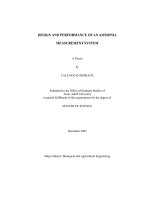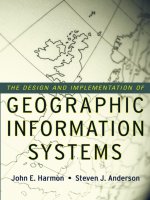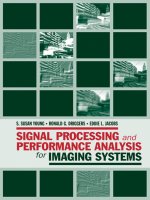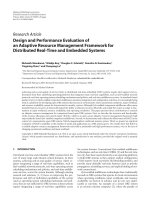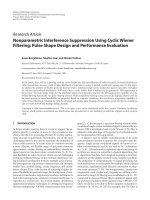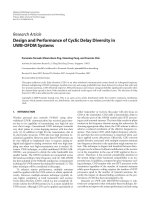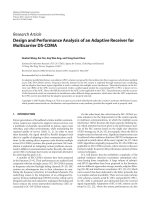- Trang chủ >>
- Khoa Học Tự Nhiên >>
- Vật lý
design and performance ofan ammonia measurement system
Bạn đang xem bản rút gọn của tài liệu. Xem và tải ngay bản đầy đủ của tài liệu tại đây (747.08 KB, 113 trang )
DESIGN AND PERFORMANCE OF AN AMMONIA
MEASUREMENT SYSTEM
A Thesis
by
CALE NOLAN BORIACK
Submitted to the Office of Graduate Studies of
Texas A&M University
in partial fulfillment of the requirements for the degree of
MASTER OF SCIENCE
December 2005
Major Subject: Biological and Agricultural Engineering
DESIGN AND PERFORMANCE OF AN AMMONIA
MEASUREMENT SYSTEM
A Thesis
by
CALE NOLAN BORIACK
Submitted to the Office of Graduate Studies of
Texas A&M University
in partial fulfillment of the requirements for the degree of
MASTER OF SCIENCE
Approved by:
Chair of Committee, Ronald E. Lacey
Committee Members, Bryan W. Shaw
Make McDermott
Head of Department, Gerald Riskowski
December 2005
Major Subject: Biological and Agricultural Engineering
iii
ABSTRACT
Design and Performance of an Ammonia
Measurement System. (December 2005)
Cale Nolan Boriack, B.S., Texas A&M University
Chair of Advisory Committee: Dr. Ronald E. Lacey
Ammonia emissions from animal feeding operations (AFOs) have recently come
under increased scrutiny. The US Environmental Protection Agency (EPA) has come
under increased pressure from special interest groups to regulate ammonia. Regulation
of ammonia is very difficult because every facility has different manure management
practices. Different management practices lead to different emissions for every facility.
Researchers have been tasked by industry to find best management practices to reduce
emissions. The task cannot be completed without equipment that can efficiently and
accurately compare emissions. To complete this task, a measurement system was
developed and performance tested to measure ammonia. Performance tests included
uncertainty analysis, system response, and adsorption kinetics.
A measurement system was designed for measurement of gaseous emissions
from ground level area sources (GLAS) in order to sample multiple receptors with a
single sensor. This multiplexer may be used in both local and remote measurement
systems to increase the sampling rate of gaseous emissions. The increased data
collection capacity with the multiplexer allows for nearly three times as many samples to
be taken in the same amount of time while using the same protocol for sampling.
System response analysis was performed on an ammonia analyzer, a hydrogen
sulfide analyzer, and tubing used with flux chamber measurement. System responses
were measured and evaluated using transfer functions. The system responses for the
analyzers were found to be first order with delay in auto mode. The tubing response was
found to be a first order response with delay.
iv
Uncertainty analysis was performed on an ammonia sampling and analyzing
system. The system included an analyzer, mass flow controllers, calibration gases, and
analog outputs. The standard uncertainty was found to be 443 ppb when measuring a 16
ppm ammonia stream with a 20 ppm span.
A laboratory study dealing with the adsorption kinetics of ammonia on a flux
chamber was performed to determine if adsorption onto the chamber walls was
significant. The study found that the adsorption would not significantly change the
concentration of the output flow 30 minutes after a clean chamber was exposed to
ammonia concentrations for concentrations above 2.5 ppm.
v
DEDICATION
I dedicate this thesis to my family and close friends. The support and love that you
provide encourages me to strive to do my best every day.
vi
ACKNOWLEDGEMENTS
I would like to thank my committee for their support throughout this research.
Dr. Lacey, Dr. Shaw, and Dr. McDermott, it has been a pleasure working with you. Dr.
Lacey, thank you for the opportunity to work with you and the CAAQES crew.
I would also like to thank the “Air Crew” for making even the worst of days
great. I will never forget the sampling trips, lunches, conferences, and long nights at the
office. In particular, I would like to thank Jackie, John, Jennifer, and Sergio. You all
will make a positive impact on air quality. May God bless your endeavors.
Finally, I would like to thank my family for their continued support. You all
were there for me through the good times and the bad. Mother, thanks for the chance to
talk over washing dishes. Father, thanks for the chance to learn how things work. The
opportunities in the shop were an experience that could never be replaced. To my
brother, Ordway, thanks for always cracking a joke at the right time. Thanks for all the
great times building random items in the shop. Your support and prayers throughout my
time at Texas A&M has been greatly appreciated.
vii
TABLE OF CONTENTS
Page
ABSTRACT iii
DEDICATION v
ACKNOWLEDGEMENTS vi
TABLE OF CONTENTS vii
LIST OF FIGURES ix
LIST OF TABLES xi
CHAPTER
I INTRODUCTION: WHY MEASURE AMMONIA FROM ANIMAL
FEEDING OPERATIONS 1
II MEASURING TECHNIQUES OF AMMONIA 4
Measurement Techniques 4
Measurement Sensors 13
III CHALLENGES FACING AMMONIA MEASUREMENT FROM
AGRICULTURAL FEEDING OPERATIONS 17
Factors Affecting Ammonia Production 17
Measuring Ammonia in Barns 21
Measuring Ammonia in Open Areas 22
IV RESEARCH OBJECTIVES 24
V DEVELOPMENT OF A PROCESS BASED MEASUREMENT
SYSTEM 25
Background 25
Goals 28
Multiplexer Programming 32
User Interface 35
Data Management 36
Enclosure 37
Summary 38
Future Improvements 39
viii
CHAPTER Page
VI PERFORMANCE OF THE SYSTEM: UNCERTAINTY 40
Methods 47
Results 53
Conclusion 57
VII PERFORMANCE OF THE SYSTEM: SYSTEM RESPONSE
ANALYSIS 58
Background 58
Materials and Methods 62
Results and Discussion 65
Conclusion 68
VIII ADSORPTION KINETICS OF AMMONIA ON FLUX CHAMBERS 69
Materials and Methods 74
Experimental Protocol 76
Results and Discussion 77
Conclusions 80
IX CONCLUSIONS AND FUTURE RESEARCH 81
Future Research 82
REFERENCES 84
APPENDIX A 89
VITA 102
ix
LIST OF FIGURES
FIGURE Page
3.1. Breakdown of animal waste. 18
5.1. Schematic of the flux sampling chamber used by CAAQES 28
5.2. Multiplexed chamber setup 29
5.3. Multiplexer control of chamber 30
5.4. Multiplexer schematic 31
5.5. Multiplexer process diagram 34
5.6. User interface of the multiplexer 36
5.7. Data flow through the sampling system 37
5.8. Enclosure with side door removed 38
6.1. Ammonia analyzer setup 42
6.2. Calibration setup for ammonia analyzer 45
6.3. Calibration procedure for NH
3
chemiluminescence analyzer 48
6.4. Flux chamber sampling method 49
6.5. Uncertainty cause and effect diagram. 50
6.6. Histogram of concentrations of ammonia samples taken from open lots. 55
6.7. Cumulative density function for ammonia samples taken from dairy open lot on
July 2004. 56
7.1. Signal flow of general linear model 61
7.2. Output error model 61
7.3. Laboratory apparatus for determination of system response 63
7.4. A plug flow reactor transfer function was found to model the time delay in the
tubing 67
8.1. Experimental apparatus consisting of mass flow controllers (MFC), flux
chamber, calibration gas, and ammonia analyzers (TEI). 75
8.2. Original Langmuir equation fit and Langmuir kinetics fit 79
8.3. Langmuir kinetics fit 79
x
FIGURE Page
A.1. LabVIEW program structure showing relationship of programs and
subprograms. 89
xi
LIST OF TABLES
TABLE Page
6.1. Uncertainty levels for instrumentation 51
6.2. Instrument uncertainty for 20 ppm full scale range 54
7.1. Step responses and transforms to common signal responses 59
7.2. System responses of NH3 analyzer to step inputs of different magnitude 65
7.3. System responses of H
2
S analyzer for various inputs 66
8.1. Chamber time constants and mass adsorbed onto chamber for various
concentrations of ammonia. 77
A.1. Details about the digital output FieldPoint modules referring to the valve
references of figure 5.5 90
A.2. Details about the digital input and analog FieldPoint modules 91
1
CHAPTER I
INTRODUCTION: WHY MEASURE AMMONIA FROM ANIMAL
FEEDING OPERATIONS
An estimated 70% or more of the total ammonia produced in the United States
originates from animal feeding operations (AFOs) (EIIP, 2004). Recently these
operations have been under intense scrutiny for their ammonia production. Ammonia is
known to have a pungent odor and may cause respiratory diseases in both animals and
humans if breathed in large quantities. Particulate matter may form when ammonia
reacts with other compounds in the atmosphere further causing respiratory damage.
Regulators are under increasing pressure to regulate ammonia emissions. However,
ammonia is neither on the list of hazardous air pollutants nor in the national ambient air
standard (U.S. EPA, 2004). The Comprehensive Environmental Response,
Compensation, and Liability Act (CERCLA) requires reporting of ammonia emissions
greater than 100 lbs per day (U.S. House, 2003). Because emission factors have been
developed only for entire operations without regard to management processes, regulators
face a dilemma of regulating an emission without an estimate of how much the operation
is producing or how a management practice may reduce emissions. Since ammonia
production is closely related to management processes, production facilities cannot be
regulated just by their animal production status but must be regulated based on facility
management practices. A science based emission factor must include relationships to
animal type and size, management practices, and climatic effects.
________
This thesis follows the style and format of ASAE Transactions.
2
Several ammonia emission factors have been published. Most emission factors,
however, lack the level of detail needed to use the emission factor for emissions
inventory work (Arogo et al., 2003). These factors are often based upon a nitrogen mass
balance method. Nitrogen inputs and outputs are calculated to determine the nitrogen
loss for a facility. The ammonia production is a function of the nitrogen loss (Phillips et
al., 2000). The mass balance method has many limitations that prevent it from being
used solely for emission factor determination. These limitations include: the inability to
measure the inputs, outputs, and storages accurately; sampling methods and errors
associated with them; and only a small portion of nitrogen is emitted as ammonia
(Phillips et al., 2000). European studies of emissions factors have generally used the
nitrogen mass balance method. Reports by Asman (1992) and Buijsman et al. (1987)
indicate that ammonia emissions in Europe for diary cattle are 39.7 kg/animal-year and
12.7 kg/animal-year respectively. The Compilation of Air Pollution Emission Factors-
Volume 1 (AP-42) uses an emissions study performed by the National Acid Precipitation
Assessment Program in 1980 (U.S. EPA, 1985). The emission factor received a poor
rating by EPA for the factor meaning that factor is believed not to be representative of
the population. Arogo, et al. (2003) reported that to determine accurate emission factors,
measurements of swine emission factors should be taken for different weight, building
types, manure treatment systems, and utilization methods.
Currently the only law regarding the emission of ammonia lies in the
Comprehensive Environmental Response, Compensation and Liability Act (CERCLA)
of 1980. The act provides broad authority to respond to release of hazardous substances
that may endanger the public. The act allows the EPA to impose fines on businesses that
emit more than the reportable quantity (RQ) of a pollutant and not report the emission.
The application of the law to animal feeding operation is questioned since the time of
emission is not given and the source is of natural origin. With current emission factors,
dairies may have to report emissions if they have as few as 500 head to have an emission
of over 100 lb/day of ammonia. Since the act is retroactive, fines could be imposed from
the time the act was passed thereby shutting down entire facilities. Currently a handful
3
of lawsuits over ammonia emissions are being debated in court. Each of the lawsuits
cites CERCLA as one reason for suit (US vs. Buckeye Egg Farm, L.P. et al., 2004;
CLEAN vs. Premium Standard Farms, 2001).
If lawsuits set precedent for retroactive regulation of ammonia emissions, one
can only envision the damage to production agriculture. Assuming the emission factor
presented by Asman (1992) was used to determine the threshold for action, the number
of head required to meet the threshold would be approximately 418 hd. Currently 58%
of Texas dairies hold over 500 head (USDA-NASS, 2002). In the US, 41.9% of the
diaries hold over 500 head. Each of these dairies could potentially be affected if
retroactive regulation occurs. Science based process emission factors may allow
operators and regulators to assess the emission to find a proactive solution.
A proper emission factor must be developed for the livestock facilities to be
fairly regulated. Over-regulation causes undo expense to the facility, but under-
regulation may be detrimental to public health. Regulators must have the necessary
tools to regulate an industry effectively. Regulators may require an industry to develop
and employ best management practices (BMPs) in order to reduce emissions.
The process of determining BMPs involves measuring individual processes
within a facility. By determining process based emission factors, the agricultural
industry may choose management processes that reduce their emissions and therefore
improve public health. Accurate data comparing each management practice must be
presented in a timely manner. In order to obtain data regarding management practices,
efficient use of equipment must be employed.
Process based emission factors are determined by measuring emissions of
individual management processes. For example, an open-lot dairy may have several
management processes such as open lots, milking parlor, solids separation, lagoons, and
compost. Along with the emissions, a nitrogen balance must take place to determine the
relationship of the management change to the overall emissions not just the specific
management process.
4
CHAPTER II
MEASURING TECHNIQUES OF AMMONIA
Ammonia measurement varies by measurement technique and measurement
sensor. Some measurement techniques are better suited for certain types of facilities
than others. This chapter discusses the measurement techniques used to measure
ammonia from AFOs and measurement sensors used to measure ammonia.
Measurement Techniques
Several measurement techniques are available to measure ammonia including:
nitrogen mass balance, plume sampling, flux enclosures, tracer gas, and source
sampling.
Nitrogen Mass Balance
The mass balance method is an indirect method. Physical samples of the source
are analyzed for their nitrogen content and by extension their emission potential. By
tracking the flow of nitrogen throughout the system, the maximum average emission
may be calculated. This method is often used as a check to make sure that the measured
emission flux is within the range bounded by the mass balance method. The mass
balance method may only be used to determine a range of accepted emissions rates due
to the uncertainties associated with measurement of inputs and outputs.
Most of the emission factor development in Europe involved nitrogen mass
balance techniques. Agricultural scientists used years of nutritional research to
determine nitrogen flows in agricultural products. Emissions were determined by
comparing the Nitrogen/Phosphorous ratio across each manure management train
(Asman, 1992).
A mass balance involves estimating the inputs and outputs of nitrogen to the
AFO. Nitrogen may be input in the form of feed and fertilizer. Nitrogen is removed
from the AFO through the sale of agricultural products, volatilization, runoff, and
5
leaching. Only a portion of the total nitrogen volatilized is released as ammonia
(Buijsman et al., 1987).
Nitrogen mass balance has been the preferred method by the US EPA to estimate
emission factors and emissions inventories. Battye et al. (1994) used emission factors
from Asman (1992) to estimate the emissions inventory for agricultural husbandry
operations in the United States. Deficiencies in the knowledgebase were noted from the
study with regard to applicability of European data to developing emission factors for
the United States. Recent updates correlating to measured data may provide a better
estimate of emissions from AFOs (US EPA, 2004).
The advantages of this method are that the method is inexpensive, following a
“cookbook” style for easy baseline regulations, and it lends itself easily as a check for
other methods. The limitations of this method are that it is difficult to characterize all
inputs and outputs and it relies on a large number of critical assumptions. This method
is likely to be used for regulatory purposes.
Plume Sampling
Plume sampling involves measuring upwind and downwind concentrations and
modeling the dispersion of ammonia. The plume sampling method involves sampling
upwind and downwind of the source and back calculating the emission rate using
dispersion modeling. This method may be used with a tower to determine the shapes of
plumes. The sampling method is similar to the particulate sampling methods described
by Sweeten et al. (1998). Dispersion modeling may be based upon Lagrangian or
Gaussian models to develop an emission rate. The solution of the Lagrangian model in
stationary homogeneous turbulence is the Gaussian model (Seinfeld & Pandis, 1998).
Plume sampling is best used for sampling moderate to high emission rates. Low
emission rates may disperse such that the concentration falls below the detection limit of
the sampler. However, plume sampling involves “chasing the plume.” For example, if
the wind drastically changes from North to West, and the sampler is set to sample down
wind of a North wind, the sampler no longer collects an emission from the source in a
6
West wind. The dispersion modeling does not take into account every condition.
Because it is a model, several simplifications are made that may introduce error if the
conditions don’t match the model. The field labor requirements of this method are
reduced dramatically from the flux enclosures method described later in this chapter.
However, the labor requirements are higher in the data processing and analysis stage due
to the requirements of modeling to obtain an emission rate from a downwind
concentration.
The advantages of the plume sampling method and limitations are presented as follows:
Advantages
• No flush time.
• Surface moisture conditions not a factor
• No change to temperature and relative humidity occur.
• The plume sampling may be used for compounds for which the volatilization is
either liquid or gas controlled.
• An unlimited number of sensors may be used to measure gas concentrations.
• Reduced labor in the field.
• May be used for 24-hour sampling periods
Limitations
• Plume sampling measures gas emissions indirectly.
• Wind direction changes result in “chasing the plume.”
• Low emission rates may have concentrations below the detectable limit of the sensor.
• Modeling is imperfect.
7
Flux Enclosures
Flux enclosures are small chambers that are placed over the emitting source.
Purified air is introduced at a known rate and the exhaust concentration is measured.
The flux of the source is calculated using:
fe
mass
A60000
QC
J = (2.1)
where:
J =emissions flux [µg/m
2
/s]
Q =flow rate [L/min]
A
fe
= Area of the footprint of the flux enclosure [m
2
]
C
mass
= Mass concentration [µg/m
3
]
Two basic types of flux enclosures exist: flux chambers and wind tunnels. The airflow
is not given a particular direction in the flux chamber. Rather, the sweep air is blown
toward the center of the chamber causing eddies to occur. In a wind tunnel, air is blown
across the surface with a given direction.
Sampling points are chosen at random for a given manure management train.
Keinbusch (1986) gives practical guidance on the sampling protocols for the chamber.
The sampling protocol may be adapted to wind tunnels easily.
The flux chamber theory is based on the two-film model (Jiang and Kaye, 1996). The
two film model is often referred to as the phenomenon of volatilization of organic
compounds. This means that the flux chamber may not be used for gases for which the
volatilization process is gas phase controlled. Both hydrogen sulfide and ammonia are
liquid phase controlled (information computed from Linstrom & Mallard, 2005 and
Jiang & Kaye, 1996). Only quiescent surfaces may be sampled with a flux chamber
since the technology is based on the two-film model. The flux chamber cannot be used
for turbulent sources.
8
According to Eklund (1992), the most important operating parameter is the
sweep air flow rate. The optimum sweep air flow rate depends on the design and
operating conditions of the chamber. If the sweep air flow rate is not operating at
optimal conditions, the emission flux may either be underestimated or overestimated. At
high concentrations of the gas being sampled, the flux chamber may actually retard the
emission of the gas from the GLAS. This occurs because the concentration nears the
gas/liquid equilibrium. Because the equilibrium is temperature and humidity dependent,
it cannot be easily determined.
The residence time for the chamber is defined as the time to completely fill the
chamber one time. Eklund (1992) suggests 3 to 4 residence times of flush before
sampling. For example, a 65 L chamber requires approximately 40 minutes of flush at 5
Lpm before sampling can occur. With a single chamber system, this equates to 40
minutes of flush time per sample where the sensors are not being used.
The advantages of the flux chamber method and limitations are presented as
follows:
Advantages
•
Simple inexpensive method to measure gaseous emissions directly.
•
EPA protocol method.
Limitations
•
Different styles and sizes of chambers
• The flux chamber may only be used for quiescent surfaces. It cannot be used for
turbulent surfaces.
• Temperature and relative humidity are influenced by solar heating during sampling
•
The flux chamber requires a 40 minute flush time before sampling.
•
The flux chamber may only be used for compounds for which the volatilization
process is liquid controlled (both hydrogen sulfide and ammonia are liquid
controlled).
9
• Sweep air flow rate must be matched to the chamber type so that emissions are not
overestimated or underestimated.
•
Emission rate may be retarded at high concentrations in the chamber.
•
Emission rate may be increased due to surface disturbance.
• May only be used during daytime due to worker safety.
Wind tunnels are rectangular structures placed over the GLAS. A fan generates
airflow through the rectangular sample chamber in such a way that the airflow sweeps
across the surface in a linear motion. The wind velocities range from 0.1 to 1.2 m/s
(Schmidt & Bicudo, 2002). This wind speed approximates the ambient wind speed. By
duplicating the ambient wind speeds, one may be able to obtain a more accurate sample.
The inlet air may be filtered for the compound to be measured. Inlet and outlet
concentrations are measured to ascertain that the sampled conditions as close as possible
to ambient conditions. If the wind tunnel is set to filter the air, only the outlet sensor is
needed for the wind tunnel. In this case, the wind tunnel and flux chamber methods may
be compared side-by-side.
Wind tunnel theory is based upon the boundary layer theory (Jiang & Kaye,
1996). Both quiescent and turbulent surfaces may be sampled with a wind tunnel. The
time between samples is reduced from the single flux chamber method because of the
increased flow rate. The wind tunnel is best used for high concentrations of the gas
being sampled. Since the flow rate is much higher for a wind tunnel, more dilution
occurs. At low concentrations, the dilution may cause the concentration to be below the
detection limit of the sampler. The increased flow rate reduces changes in humidity and
temperature within the system. The reduced response time gives the ability to increase
the number of sensors which sample the air. Since no standards exist for the design of
the technology, different size and shape relationships may affect emissions. To avoid
this problem, Schmidt and Bicudo proposed a standard design for a wind tunnel (2002).
The proposed design follows a wind tunnel developed by Lockyer (1984).
The advantages of the wind tunnel method and limitations are presented as follows:
10
Advantages
•
The wind tunnel method measures gaseous emissions directly.
•
Flush time is significantly less with a wind tunnel due to the increased wind speeds.
•
The wind tunnel may be used for quiescent surfaces and turbulent surfaces.
• Temperature and relative humidity are relatively close to the ambient conditions due
to the rapid air exchange of the system.
•
The wind tunnel may be used for compounds for which the volatilization is either
liquid or gas controlled.
•
An increased number of sensors may be used to measure gas concentrations.
Limitations
•
Air flow rate must be matched to the ambient conditions so that emissions are not
overestimated or underestimated.
•
Low emission rates may have concentrations below the detectable limit of the sensor.
•
Emission rate may be increased due to surface disturbance.
•
No standards for technology.
•
May only be used during daylight at some sites due to worker safety.
Trace Gas
The trace gas method involves releasing a trace gas at a given rate. The
concentrations of ammonia and trace gas are measured downwind. The flux of ammonia
may be calculated using equation 2.2.
11
tracer
NH
tracer
NH
C
C
J
J
33
= (2.2)
where:
3
NH
J = Flux of ammonia [µg/m
2
/s]
tracer
J = Flux of trace gas [µg/m
2
/s]
3
NH
C
= Concentration of ammonia [µg/m
3
]
tracer
C = Concentration of trace gas [µg/m
3
]
The trace gas method has been used in the Netherlands to measure the ammonia
emissions from naturally ventilated buildings (Mosquera et al., 2005). Sulfur
hexafluoride (SF
6
), the trace gas, was injected near the NH
3
source. The concentrations
of both SF
6
and NH
3
were measured near the exhaust of the building. A gas
chromatograph fitted with an electron capture detector (ECD) was used to measure the
SF
6
concentration and an AMANDA rotating annular denuder was used to measure the
concentration of NH
3
(Scholtens et al., 2004).
The advantages of the trace gas method and limitations are presented as follows:
Advantages
• May be used in naturally ventilated and mechanically ventilated structures
• Dispersion modeling not required.
Limitations
• Trace gas must be emitted near ammonia source
• Multiple trace gas outlets required for sampling
• Multiple measurement points required in building
12
Source Sampling
Source sampling involves measuring the flowrate and concentrations of exhaust
points. This method is primarily used for mechanically ventilated structures and
industrial exhaust stacks. Heber et al. (2001) developed a methodology to sample swine
finishing barns. Dust was filtered at each sampling point with the use of a Teflon
membrane filter.
Measurement of airflow is by far the greatest challenge in mechanically
ventilated buildings. The airflow from each fan changes with the static pressure of the
building. The static pressure changes with the number of fans running and the speed of
variable speed fans. Fan performance generally does not match fan curves. The
performance of a fan varies with the loading of dust on the blades. One method of
measuring fan performance is by using the fan assessment numeration system (FANS)
system developed by Simmons et al. (1998). Fans are tested in place with static
pressures ranging from free air to 40 Pa (Gates et al., 2004). With the use of FANS a
new fan curve may be developed for each fan in approximately 30 minutes.
The advantages of the source sampling method and limitations are presented as
follows:
Advantages
• May be used in mechanically ventilated structures
• Dispersion modeling not required.
Limitations
• May not be used in naturally ventilated systems
• Multiple trace gas outlets required for sampling
• Multiple measurement points required in building
• Adsorption on dust not quantified
13
Measurement Sensors
Ammonia emissions may be in the form of ammonia gas and ammonium
particulate. Ammonia emissions may be measured using continuous emission monitors,
wet chemistry, and particulate samplers. Ammonia gas is measured by many different
methods including chemiluminescence, near-infrared light, ultraviolet (UV) light,
electrochemical cells, and wet chemistry.
Ammonia gas measurement
Chemiluminescence involves converting the ammonia to nitric oxide and
measuring the luminescence caused by nitric oxide and ozone reacting in the mixing
chamber (Thermo, 2002a). The chemiluminescence analyzer measures NO, NO
x
, and
NH
3
. A stainless steel converter heated to 750ºC is used to convert NH
3
to NO. A
molybdenum converter heated to 325°C is used to convert NO
2
to NO. The analyzer
multiplexes the three sampling streams to determine the concentration of NH
3
.
Near -infrared sensors include photo-acoustic and direct optical absorption
sensors. Infrared detectors detect light absorption at 1500 nm wavelength range
(Webber et al., 2001). This wavelength is chosen to reduce interference of water and
carbon dioxide present in the measured gas. The photo acoustic sensor measures
pressure differences caused by ammonia absorbing and desorbing light (Bozoki et al.,
2002). The direct optical absorption sensor measures the adsorption of a selected
ammonia adsorption line (Bozoki et al., 2002).
Ultraviolet instruments based upon differential optical absorption spectroscopy
(UV-DOAS) have been used for open path measurement of ammonia from area sources.
Ammonia absorbs UV light in the 190-230 nm range (Phillips et al., 2001). A Xenon
light source is focused on a receiver placed up to 1000 m away (Myers et al., 2000). A
tunable spectrometer measures the absorption of ammonia. The modulated light source
emits one wavelength that ammonia does not absorb and one wavelength that ammonia
absorbs. The instrument has an interference with components that may attenuate the
light beam (Stevens et al., 1993). These components may be fog, rain, high humidity
14
and dust. Alignment of the transmitter and receiver could be troublesome in field
measurements without an auto alignment mechanism.
Electrochemical cells are small semiconductor circuits that are sensitive to
certain chemicals. The resistance or capacitance changes with concentration. These
sensors have been primarily used as toxic gas monitors. The EC-NH
3
-100ppm
(Manning Systems Inc, Lexana, KS) has an accuracy of 5% and a repeatability of 2%
full scale (Manning, 2002). Wenger et al. (2005) reported that the Toxi-Ultra ammonia
sensor (Biosystems Inc., Middleton, CT) performed poorly in an agricultural facility.
Hydrogen sulfide reacted with the sensor causing erroneous readings and premature
failure of the sensors.
Wet chemistry involves absorbing ammonia onto an acid solution. The The
ammonia measurement by annular denuder sampling with on-line analysis (AMANDA)
system uses a rotating annular denuder to capture ammonia. Ammonia gas is absorbed
in the acid solution that is pumped through the denuder. Sodium hydroxide is added to
the acid solution and passes across a membrane to deionized water where the
conductivity is measured (Phillips et al., 2001). Classic denuders have used dried oxalic
acid or citrus acid. The acid is washed from the sampler and then titrated with sodium
hydroxide to determine the concentration of ammonia (Leuning et al., 1985).
Particulate Ammonium
The measurement of particulate matter and ammonia in the past has generally
been a disjointed process. This was primarily because of the lack of understanding of
the atmospheric phenomenon in the formation of particulate ammonium.
Particulate matter is generally measured using a gravimetric sampler. This
sampler has an inlet that excludes certain size particles. Currently total suspended
particulate (TSP), PM
10
, and PM
2.5
inlet heads are available. A filter placed after the
inlet captures particles that penetrate the inlet. A vacuum pump is used to pull air
though the inlet head and filter at a measured flow-rate. Gravimetric sampling entails
weighing a filter before and after sampling to determine the weight of particulate

